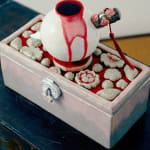-
Shayne Phua
The Ornamented Knife confronts the Pure, Unadorned Moon, 2024Ceramic with fountain pump and pipe, tassels, and silver gilding22 x 27.5 x 15 cmFurther images
One of several fountains in the current exhibition, this work features a moon jar pierced through with a blade dubbed an eunjangdo. It was inspired, Phua notes, by the South...One of several fountains in the current exhibition, this work features a moon jar pierced through with a blade dubbed an eunjangdo. It was inspired, Phua notes, by the South Korean film, Homme Fatale (2019). The moon jar is a traditional Korean vessel, typically cast from white porcelain and asymmetrical in its top and bottom halves, that appeared during the Joseon dynasty. The moniker, a twentieth-century coinage, comes from its hue and shape. The moon jar became popular in Korea for its supposed embodiment of neo-Confucian values; its pristine appearance symbolized purity, and its unadorned surfaces, a sense of restraint. The eunjangdo is a silver knife carried or worn by women as an emblem of chastity (for maidens) and fidelity (for married women), and used in the service of self-defence or even suicide, if necessary. The meeting of the two objects in a violent encounter – one a signifier of morality, the other a weapon of self-sacrifice – suggests the turning of the pre-modern ideal of female virtue, which privileged death over the loss of chastity, on itself. The puncturing of the jar may be understood as an act of aggression against neo-Confucian strictures, a feminist reaction to historical power asymmetries.Mostre
A roast of Asian nine tails topped with broken femur and bile, accompanied by more curious ingredients, 20 July – 1 September 2024, Yeo Workshop, Singapore







